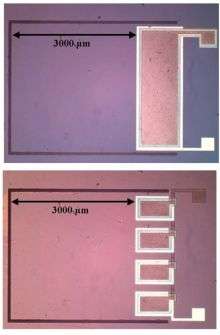IMEC reports 40 microwatt from micromachined piezoelectric energy harvester

IMEC has fabricated an energy harvester to generate energy from mechanical vibrations by using micromachining technology. The harvester comes together with a model which can be used to optimize the device during design. Output powers up to 40µW were obtained which are in range of the required power for wireless sensor applications.
Energy harvesters, transforming ambient energy into electrical energy, are of great value for situations in which batteries cannot be replaced easily. A typical example is autonomous sensor networks that are spread over large areas or placed in locations that are difficult to access.
Vibration harvesters in general make use of electromagnetic, electrostatic or piezoelectric conversion to generate electrical power. IMEC developed, modeled and characterized a miniaturized vibration harvester based on a piezoelectric transducer.
For an input vibration with a resonance frequency of 1.8kHz and an amplitude of 180nm, a maximum experimental output power of 40µW was measured. This comes well in range of the amounts of power needed by wireless sensor applications, such as the pulse-oxymeter developed earlier by IMEC and IMEC-NL, operating from the Holst Centre in Eindhoven (The Netherlands).
"After the demonstration of a battery-less pulse-oxymeter, which is fully powered by a thermal scavenger, this is another encouraging result which brings us closer to seeing miniaturized scavengers in real-life applications. We believe that first of such devices will see market introduction in 5 years from now and will become mainstream by the end of next decade;" said Bert Gyselinckx, Program Director IMEC-NL in the Holst Centre.
The device consists of a piezoelectric capacitor formed by a Pt electrode, a PZT layer and a top Al electrode. This capacitor is fabricated on a cantilever that supports a mass on its tip. As the harvester is subjected to oscillations, the mass causes the piezoelectric layer to be stretched. By doing so, it induces an electrical power when an electrical load is connected to the device.
To optimize the proposed device concept, a model was generated to estimate the output power for a given design. The output power of the fabricated devices can be maximized by maximizing the quality factor Q (through a low parasitic dissipation) and the coupling between the electrical and mechanical part (GEMC; generalized electromechanical coupling factor).
Source: IMEC





















